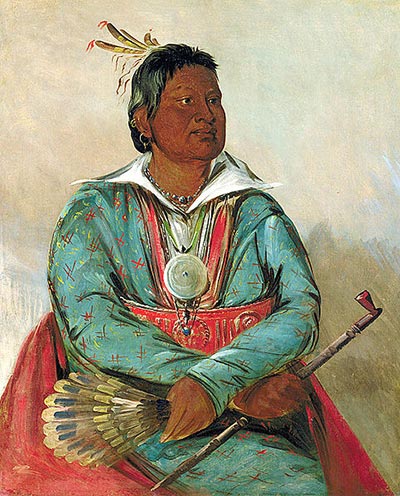A week before the Fort Mims attack on August 30, 1813, a Choctaw man reported that he had seen a large contingent of Creeks on the move near the Alabama River. Although some Choctaw and Creek people counted relatives among the villages of the other Nation, historically they had more often warred against one another. Ultimately the attack on settlers at Fort Mims, and actions of some Creeks to militantly resist changes brought about by an invasive American presence, forced Choctaws to respond.

Smithsonian American Art Museum
The Creek Indians faced an increasingly intrusive American presence on their lands in the early 19th Century. An 1805 treaty with the United States led to the establishment of the Creek Federal Road, a horse-and-wagon path that ran through the heart of Creek country. Between late 1811 and early 1812, more than 3,500 white travelers and black slaves passed through the Creek territory. Such traffic disrupted Creek hunting and brought undesirable goods like alcohol into their towns. Further, hundreds of illegal white squatters occupied Creek lands beyond the Ocmulgee River, the official boundary between Georgia and the Creek Nation after 1805.
By 1812, a faction of Creeks called Red Sticks, inspired by the teachings of Tecumseh and their own prophets, began working to reform Creek culture to remove commercial and American influences that they deemed harmful to Creek values and sovereignty. Tensions grew between the Red Sticks and other Creeks as the Red Sticks adopted militant resistance to confront Creeks who they deemed too accommodating to American demands or cultural influences. In the summer of 1813, Red Sticks acquired guns and ammunition from Spanish-held Pensacola and were attacked by other Creeks at the Battle of Burnt Corn Creek on July 21. In response, Red Sticks overwhelmed Fort Mims (located on the lower Alabama River in present-day southwestern Alabama) in late August. Upon defeating the militia garrisoned on the fortified plantation, the Red Sticks killed nearly every Creek and white settler who had sought refuge there. The dramatic victory by the Red Sticks at Fort Mims resonated across the United States by heightening anxieties deriving from the War of 1812 and the perception that the British had armed Indians to kill Americans.
As the Red Stick Creek resistance melded into the War of 1812 and Creek country split into warring factions, it remained to be seen what the next largest Native group in the area—the Choctaws—would do. Americans living in the Mississippi Territory wondered whether Choctaws might join the Red Stick rebellion, but the three primary Choctaw chiefs, Pushmatha, Mushulatubbee, and Apuckshunubbee, acted quickly to keep Choctaws neutral in the conflict or to join the American side as soldiers. They failed to keep all Choctaws on the American side, however, as a sizable number of Choctaws supporting the Red Stick movement fled to the swampy grounds of the lower Alabama River region. But the chiefs, especially Pushmataha, used their influence among their relatives—including Euro-American traders who had settled among the Choctaws and their mixed-ancestry children—to organize resistance against the Red Sticks and to seek recognition of their efforts by United States officials as soldiers in the U.S. Army.
Last updated: August 14, 2017
